Essex Industrial School for Boys, Chelmsford, Essex
The Essex Industrial School for Boys was founded in 1872 by Mr. Joseph Brittain Pash, of Chelmsford. Its first premises were a pair of ordinary dwelling houses at Baddow Road, Chelmsford. The School was formally certified to begin operation on March 4th, 1873. The superintendent and matron were Mrs and Mrs Shepherd. By the following year, two further houses had been, taking its total accommodation up to 50 places, with around 12 in each of the four properties. The boys' industrial training consisted of tailoring and shoemaking, with some of the younger boys employed in paper-bag making. The superintendent was now Mr Jarvis.
Early reports of the School lauded Mr Pash's efforts in establishing the School although the general lack of space and very small dormitories were noted as a concern. A large schoolroom of wooden construction was added in 1875, by which date Mr Goodall had taken over as superintendent. The other staff now comprised the matron, schoolmaster, shoemaker, tailoress and general assistant.
In 1876, it was noted that a fife and drum band had now been established and that the boys were drilled daily. Mrs Barrett was recorded as the School's matron. An 11-acre site was for a new building at Rainsford Road, Primrose Hill, Chelmsford, with £5,000 contributed towards the construction costs by the County of Essex, and £2,000 by the West Ham School Board. The older boys at the School contributed to the building operations at the new house, digging and clearing the ground etc. In 1877, there was another change of superintendent, with Mr Collins now in charge.
On February 4th, 1879, the new premises were certified to begin operation. The following day, the School was formally opened by the Home Secretary, Mr R.A. Cross. Six commemorative trees were ceremonially planted along the south side of the main block. The buildings, which provided accommodation for 150 boys, were designed by the Essex County Surveyor, Mr Stock. A contemporary report described the layout as follows:
Although not mentioned in the above report, the new School's facilities also included a swimming bath. In the new location, Joseph Pash took on the title of manager and director, which encompassed the former superintendent's role.
The School site is shown on the 1921 map below.
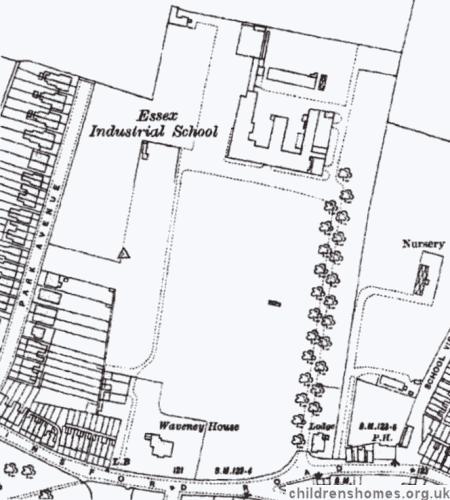
Essex Industrial School for Boys site, Chelmsford, c.1921.
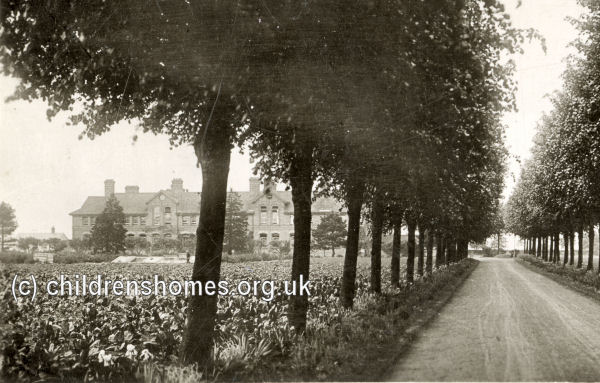
Essex Industrial School for Boys from the south, Chelmsford, early 1900s. © Peter Higginbotham
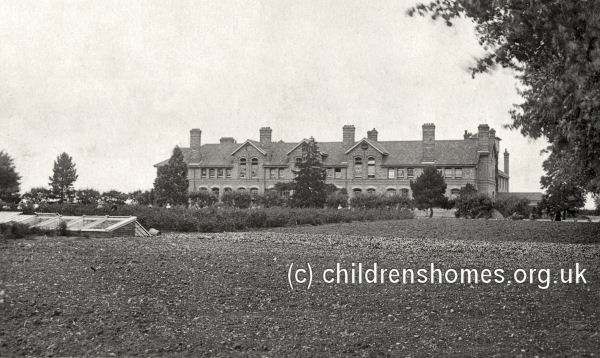
Essex Industrial School for Boys from the south, Chelmsford, early 1900s. © Peter Higginbotham
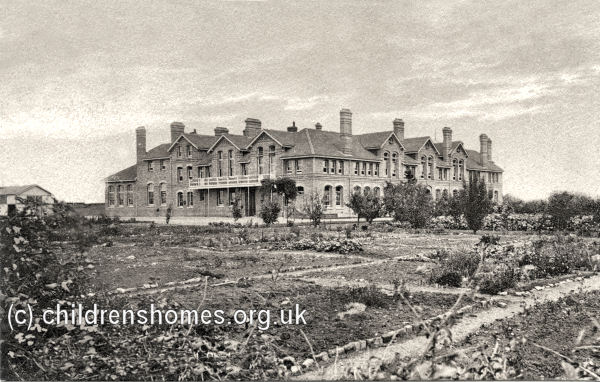
Essex Industrial School for Boys from the south-west, Chelmsford, early 1900s. © Peter Higginbotham
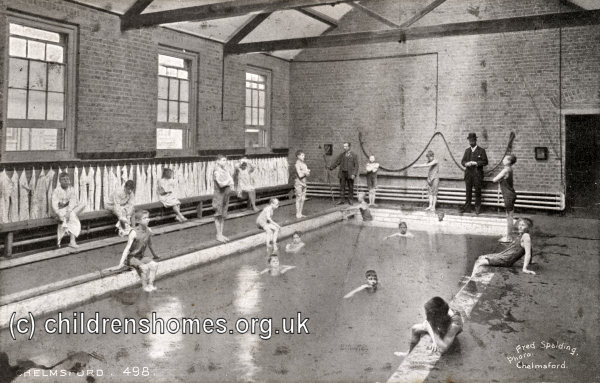
Essex Industrial School for Boys swimming bath, Chelmsford, early 1900s. © Peter Higginbotham
The boys spent half of each day in the classroom and the other half undergoing industrial training. As at Baddow Road, this continued to include tailoring and shoemaking, with carpentry now added. The large garden also provided considerable employment, supplying the School with vegetables and sending some fruit to the local market.
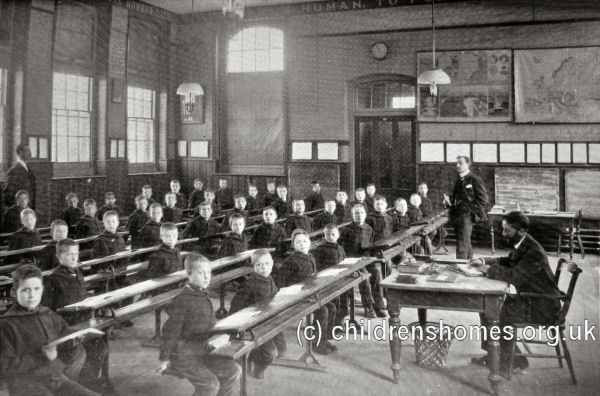
Essex Industrial School for Boys schoolroom, Chelmsford, early 1900s. © Peter Higginbotham
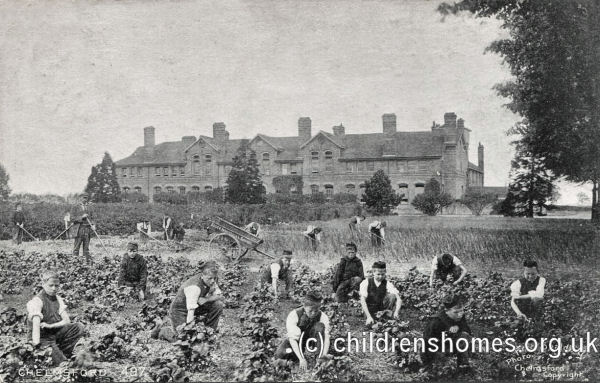
Essex Industrial School for Boys gardening, Chelmsford, early 1900s. © Peter Higginbotham
In 1880-81, during Joseph Pash's extended illness, his brother Arthur stood in for him as Honorary Director of the School.
In 1893, it was noted that 20 boys were working with the tailor, with a junior class doing darning and knitting, and several knitting machines were in use. There were 24 boys working with the shoemaker. Up to a dozen boys assisted in the laundry. Woodworking had been introduced, and a class of 32 boys were receiving instruction in the Slojd (or Sloyd) system. The boys sang well and a good band was maintained. There is a good drill-yard and the gymnasium was also used as a play-shed.
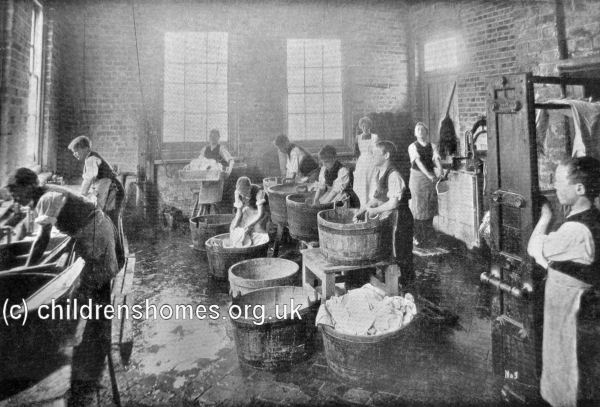
Essex Industrial School for Boys washing day, Chelmsford, early 1900s. © Peter Higginbotham
In the 1890s, the School adopted a mark system, where pocket-money was earned by good conduct. The boys were encouraged to bank the money by receiving half-yearly interest of 2d. on every shilling The school library contained about 300 books, which were extensively used in the winter, when indoor games were also supplied. Gifts of old periodicals were received from time to time.
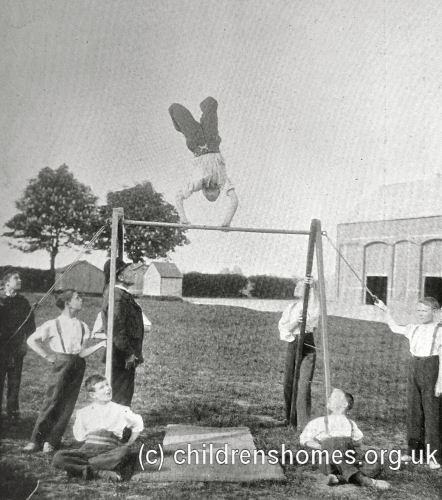
Essex Industrial School for Boys gymnastics, Chelmsford, early 1900s. © Peter Higginbotham
Joseph Pash retired in 1903 and Mr Charles W. Hayward was appointed superintendent, with Mrs Hayward as matron.
An interesting insight into life at the School is given by a postcard sent in 1906 by by one of the inmates. It complained that 'the hours are 80 per week' and that 'Smith', presumably another inmate, 'broke down completely.'
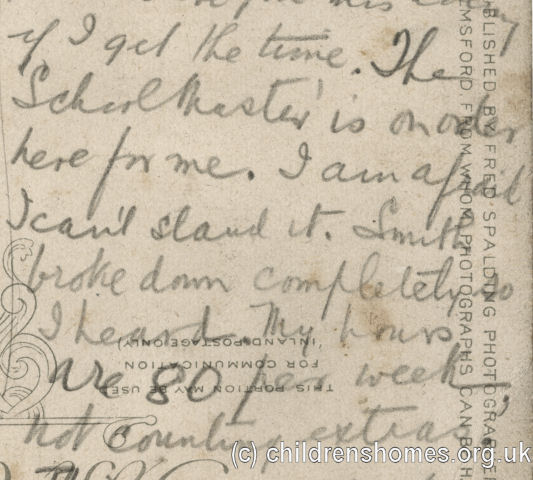
Essex Industrial School for Boys postcard from inmate, Chelmsford, early 1900s. © Peter Higginbotham
From 1924, the institution was known as the Essex Home School. In 1933, it became an Approved School, one of the new institutions introduced by the 1933 Children and Young Persons Act to replace the existing system of Reformatories and Industrial Schools. The School now accommodated up to 130 Junior Boys aged between their 10th and 13th birthdays at their date of admission. The headmaster was now Mr R.H. Fish.
In 1960, the School dormitories were converted into Nelson House — a 'house unit' for 35 boys and included small bedrooms each sleeping up to 6 boys. Two further self-contained units, named Churchill and Drake Houses, were built in the School grounds.
In 1973, the School became a Community Home with Education (CHE) under the control of Essex County Council. It closed in around 1980.
The School buildings no longer survive and the site is now covered by a housing estate.
Records
Note: many repositories impose a closure period of up to 100 years for records identifying individuals. Before travelling a long distance, always check that the records you want to consult will be available.
- Essex Record Office, Wharf Road Chelmsford CM2 6YT. Extensive holdings include: Admission registers (1872-1975); Discharge registers (1872-1975); Joint Admission/Discharge registers (1975-78); Log books (1923-80); Punishment books (1923-80); Absconders books (1955-79); Visitors books (1872-1974); Annual reports; Minutes; Building plans; Photographs; etc.
Census
Bibliography
- Higginbotham, Peter Children's Homes: A History of Institutional Care for Britain's Young (2017, Pen & Sword)
- Mahood, Linda Policing Gender, Class and Family: Britain, 1850-1940 (1995, Univeristy of Alberta Press)
- Prahms, Wendy Newcastle Ragged and Industrial School (2006, The History Press)
- Higginbotham, Peter Children's Homes: A History of Institutional Care for Britain's Young (2017, Pen & Sword)
- Hyland,Jim Yesterday's Answers: Yesterday's Answers: Development and Decline of Schools for Young Offenders (1993, Whiting and Birch)
- Millham, S, Bullock, R, and Cherrett, P After Grace — Teeth: a comparative study of the residential experience of boys in Approved Schools (1975, Chaucer Publishing)
Links
- None noted at present.
Except where indicated, this page () © Peter Higginbotham. Contents may not be reproduced without permission.


